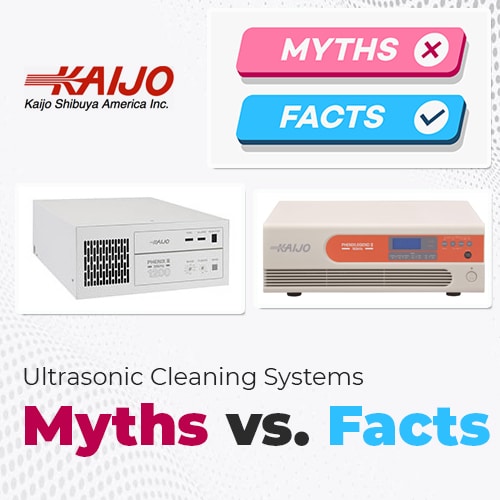Ultrasonic Cleaning Systems: Myths vs. Facts
January 11, 2022
 Despite myths to the contrary, if ultrasonic cleaning systems are configured correctly for a cleaning application and are used properly, they can clean almost anything. Whether a competent and experienced manufacturer of ultrasonic cleaners delivers a standard system or designs and builds one for a special application, ultrasonic cleaning systems clean more quickly and more completely than alternative cleaning methods. Myths about damage to parts or lack of cleaning power can be traced back to using the wrong system or using it incorrectly. Common myths and the actual facts are discussed below.
Despite myths to the contrary, if ultrasonic cleaning systems are configured correctly for a cleaning application and are used properly, they can clean almost anything. Whether a competent and experienced manufacturer of ultrasonic cleaners delivers a standard system or designs and builds one for a special application, ultrasonic cleaning systems clean more quickly and more completely than alternative cleaning methods. Myths about damage to parts or lack of cleaning power can be traced back to using the wrong system or using it incorrectly. Common myths and the actual facts are discussed below.
Ultrasonic Cleaners Will Damage a Part’s Soft Surfaces or Delicate Structures
When cleaning complicated parts such as printed circuit boards or semiconductors, an ultrasonic cleaner operating at a low frequency can damage solder joints on printed circuit boards or delicate structures on processors or other semiconductor components. When such damage occurs, it means the system frequency is too low. A knowledgeable manufacturer would recommend that the customer use a higher frequency, delivering a more-gentle cleaning action, to avoid damaging these types of parts and components. Ultrasonic cleaners operating at the highest frequencies can quickly clean very soft surfaces and fragile components without any damage.
Parts Have to Be Pre-Cleaned Before Ultrasonic Cleaning
While washing, wiping, or brushing the parts to be cleaned before placing them in the ultrasonic bath may reduce the cleaning time, pre-cleaning is usually more time-consuming than just letting the ultrasonic cleaner do the whole job. Correctly configured ultrasonic cleaning systems have no need for pre-cleaning and can clean even severely contaminated parts.
Parts Made from Aluminum Can’t Be Cleaned with an Ultrasonic Cleaner
Aluminum is a relatively soft metal and aluminum surfaces can suffer pitting if the ultrasonic cleaning action is too powerful. Hard metal surfaces such as steel or bronze can be cleaned at the lowest ultrasonic frequencies, but aluminum needs the gentler cleaning action of slightly higher frequencies to avoid pitting. When the frequency is chosen correctly, aluminum parts can be cleaned quickly and effectively.
Ultrasonic Cleaners Can’t Sterilize Medical Instruments and Devices
It’s true that the ultrasonic cleaning process itself does not kill pathogens, but an ultrasonic cleaning system can still be designed to sterilize the parts to be cleaned. Ultrasonic cleaning dislodges contaminants including pathogens from the surfaces of the parts to be cleaned but does not sterilize the parts during this process. To sterilize medical instruments and devices, an appropriate amount of disinfectant should be added to the ultrasonic cleaning solution. When pathogens are removed from part surfaces, the disinfectant in the solution acts to sterilize the parts.
Longer Cleaning Times Result in Cleaner Parts
This is often true for many traditional cleaning methods, but not for ultrasonic cleaning. Ultrasonic cleaners act quickly to remove all contamination on a part surface. Leaving the part in the cleaning bath longer does not result in a cleaner part. An experienced manufacturer of ultrasonic cleaning solutions can recommend adequate cleaning times for a specific application.
Ultrasonic Cleaning Systems Don’t Clean Very Well
When an ultrasonic cleaning system does not perform as expected, it is usually not designed for the specific cleaning application. Frequency, power, heating and the addition of detergents to the cleaning solution all have to be matched to the nature of the contaminant and the type of parts to be cleaned. If the system configuration matches the cleaning application, the ultrasonic cleaning system will clean parts faster and more completely than traditional methods.
With extensive experience in the field of ultrasonic cleaning and a wide range of in-house expertise, Kaijo is ideally suited to recommend an ultrasonic cleaning system for a specific cleaning application. Kaijo offers free consulting and can back up the recommendation with equipment from a complete line of ultrasonic cleaners. Ultrasonic cleaning systems from Kaijo will operate as expected and meet the requirements of the cleaning application.





